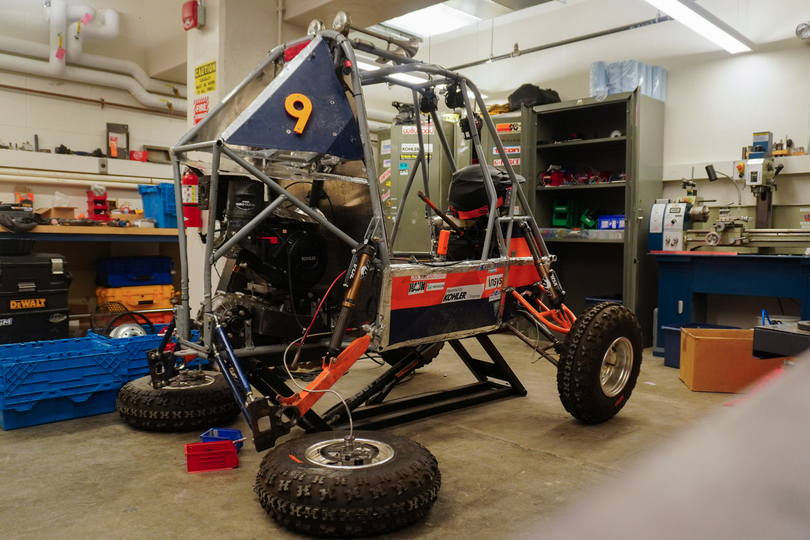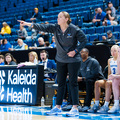Cuse Baja veers past required coursework, builds cars across experience levels

Cuse Baja engineering students work together to build off-road vehicles that they drive in competitions. The car has to compete in hill climbs and maneuverability and suspension courses, as well as a four-hour wheel-to-wheel endurance race. Angelina Grevi | Staff Photographer
Get the latest Syracuse news delivered right to your inbox.
Subscribe to our newsletter here.
Inside Link Hall, a room at the end of the hallway bursts with noise. Machines whirring with energy line the interior, while sparks fly in every direction from welding metal. Students surround a racecar painted orange in the center of the room.
“We’re a student racing team, we always say, there are no requirements at all, you just have to show up,” Riehen Walsh, president of Cuse Baja, said.
Syracuse University’s Cuse Baja is a registered student organization that designs and builds off-road vehicles to compete against other schools. Most recently, the team competed in Holly, Michigan last fall.
Though the original club started decades ago, Walsh said it was brought back to campus in 2017. Shortly after, the small crew started working on building a CBO3 car for competition.
The vehicle, similar to a dune buggy, had to be ready to compete in hill climbs and maneuverability and suspension courses, as well as a four-hour wheel-to-wheel endurance race.
The chassis team focused on the frame, while other subgroups handled features like ergonomics and weight. After building the car for nearly five years, Cuse Baja won their first competition in 2024.
The original Cuse Baja cars in the ’80s and ‘90s last finished a race in 2004. CBO3 was the first car Cuse Baja used to complete a competition in 20 years. Now, the team has competed in four total events since back on campus: Michigan, New Jersey, Pennsylvania and Ohio.
The team hopes to complete their new car, CBO4, by 2027, the current juniors’ graduation year, so they can watch it compete.
Walsh joined the club as a freshman in 2023. There were only four or five members at the time, he said. Since then, Cuse Baja has grown to 36 members, with a focus on improving retention and recruitment
When the club returned, most of the meetings were organized based on what the car needed at that moment, Walsh said, which made scheduling a challenge. Now, they’re starting to have meetings every week when most people can attend.

In the last four years, Cuse Baja has grown their membership from four to 36. The group hopes to complete their new car and win a competition before the current juniors graduate. Courtesy of Riehen Walsh
The design process begins with deciding desired speed, suspension system and driver size, Walsh said. Once specifications are set, Peter Derro, SU junior and chief engineer, and the rest of Cuse Baja creates other parts, like a drive train and frame. Adjustments are made along the way. Then, the group tests the car to prepare for competition.
During events, members, along with repairing and organizing the car, are also in the driver’s seat. Both the vehicle and crew are decked out in Syracuse’s shade of orange, with mud and dirt layered on their arms after hours of work.
Walsh said around half of what they know about the process comes directly from engineering classes at SU. They apply what they’ve learned in class about design and simulation when working on the car. The rest of their knowledge comes from hands-on experience and learning from other members. Walsh said the club has provided him with an opportunity to learn past the homework phase and actually build a car.
“I might be stressing over my classes, but I get to step back and be like, ‘Oh I’m not doing homework, I’m actually working on the car and doing something fun,’” Walsh said. “It’s very fulfilling but it also makes you better overall in classes and as an engineer.”
To gain more members, Walsh said they had to acknowledge the lack of experience in building cars. He wanted to make it a space where new members don’t have to wait to get involved in the club.
“One issue that we’ve seen is new members don’t get to even touch the car until their junior or senior year,” Walsh said. “We’re going to work on something and if you guys are interested in learning how to make a frame or something, come with me and I’ll actually teach you guys.”
Laney Price, the club’s vice president, said the team emphasizes inclusivity just as much as engineering. They want the club to feel open to anyone who wants to join.
“We’re trying to build a community rather than just a club,” Price said.
The club’s executive board bonded early as engineering students living in Shaw Hall. After competing with CBO3 during their freshman year, they were motivated to start working on their own.
Walsh said Cuse Baja has opened doors professionally, leading to club sponsorships, industry connections and internships at Syracuse-based companies. Even being a non-board member in the club greatly improves leadership skills and boosts your resume, he said.
For Derro, becoming chief engineer has been an unexpected transition. He joined the club out of a love for cars, and started learning how parts worked through presentations upperclassmen organized. His leadership role has forced him to change his approach in the race room, he said. He can no longer rely on others for information; now, he’s the one members are looking to for advice.
While making a competition-proof car may seem daunting, no one is an expert, Derro said. It’s not just about working together but also learning from others, he said. When walking into the race room, everyone is trying to gain as much knowledge as possible to make the car the best it can be, he said.
Now in his third year at Baja, Walsh has his eyes set on more competition. He hopes the original crew and new members can come together for a victory.
“We’ll run and we’ll show up, pass everything we need to pass and then compete against all the schools,” Walsh said. “And we will go there and we will have a car that we know will be competitive and all the other schools will be scared of us.”






